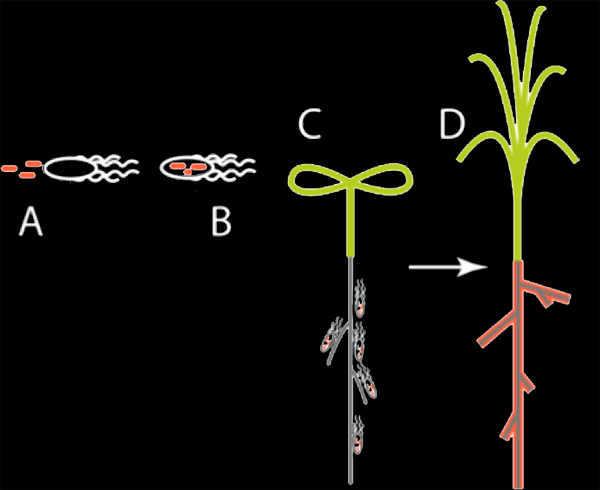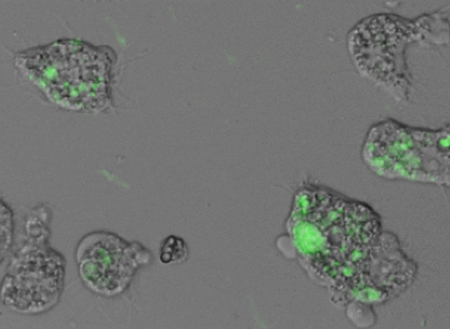
Gage Lab
Dept. of Molecular and Cell Biology
University of Connecticut - Storrs
Research-Soil Protists
Using protists to transport beneficial bacteria along roots
In return for carbon-rich root exudates, microbes in the rhizosphere provide essential services. Some bacteria enhance growth of their host plants when present in the rhizosphere (Plant Growth Promoting Rhizobacteria - PGPR). Much publicly- and privately-funded research has gone into identi-fying and developing such strains. Many are currently used in agricultural settings in the United States and around the world. Inoculating plants with PGPR is often a cost effective way to improve yields. Often, however, PGPR are ineffective. This can be caused by: Restricted movement of PGPR; Inefficient water-based transport of PGPR; Competition with endogenous bacteria. Work funded by the USDA is aimed at harnessing cyst-forming soil protists to efficiently move PGPR through microfluidic environments that mimic aggregated soils and along roots of model plants such as Medicago truncatula. In the Gage Lab this work is being done by Gabrielle Corso and Jamie Miccullia
A related project uses these protists to move bacteria-sized particles that can be loaded with chemical cargo through microfluidic environments that mimic aggregated soils. This work is done in collaboration with Dr. Leslie Shor, and Dr. Robert Prud’homme
Understanding how protists affect rhizosphere biology
The goal of this project is to link protist diversity in the crop rhizosphere to functional understanding of protist roles in plant and soil health. We are:
•Describing the natural protist diversity in the rhizosphere of field-grown maize
•Establishing a culture collection of maize rhizosphere protists
•Characterizing ecologically relevant phenotypes of protist isolates, such as prey selectivity
• Determining the impact of protist isolates on the maize bacterial microbiome
This is being done through a combination of metataxonomic sequencing of rhizosphere protist and bacterial populations, characterization of protist isolates, greenhouse experiments measuring the interactions of protist and rhizosphere bacteria and how those interaction affect microbiome structure, plant health, and soil nutrients.
This work is a collaboration between the Gage Lab and the labs of Lindsay Triplett and Blair Steven at the Connecticut Agriculture Experiment Station.
Select papers -Protists/Tranport

Diagram showing how protists can move beneficial bacterial along developing root systems
Rubinstein, R., Kadilak, A., Cousens, V., Gage, D. J. and L. Shor (2015). Protist-facilitated particle transport using emulated soil micromodels. Environ. Sci. Tech. Environ. Sci. Technol. 49:1384-1391. get pdf
Select papers -Protists Microbiome

Acanathamoeba that have consumed GFP-tagged S. mellloti
A nice review (not our work though): Gao et al. (2019) Protists: Puppet Masters of the Rhizosphere Microbiome. Trends in Plant Sci. 24:165. get pdf